
Ontario Multi Barrier Approach
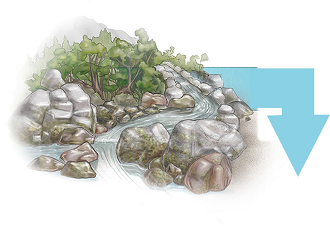
Source Water Protection
Our sources of drinking water are lakes, rivers and groundwater aquifers. By protecting these sources from contamination and depletion, we can enjoy clean and abundant water for future generations. Ontario’s Clean Water Act helps protect sources for our municipal drinking water systems.
Read More |
| Source water refers to untreated surface water from lakes and rivers and groundwater aquifers from which we get the water to supply drinking water systems. All of these sources of water are linked in a watershed through the water cycle. Drinking water sources can be easily contaminated from a variety of activities performed on the landscape. Long-term problems can develop that are costly or even impossible to correct. Source water protection is about protecting these water sources from both contamination and depletion, ensuring a long-term supply of clean water for future generations. Today, Ontario has a comprehensive drinking water protection framework from source to tap. After the tragic events of 2000 in Walkerton, Ontario a public inquiry was held. Justice O’Connor made 121 recommendations on a wide range of areas related to protecting drinking water. These recommendations became the building blocks of Ontario’s drinking water protection framework.
One of Justice O’Connor’s recommendation was that drinking water should be protected by developing watershed-based source protection plans. As a result, the Clean Water Act was created in 2006 to ensure municipalities protect their existing and future drinking water supplies through prevention. Through the creation and implementation of collaborative, watershed-based source protection plans that are locally driven and based on science, sources of municipal residential drinking water are now protected. Certain other types of drinking water systems can also be brought under the source protection planning process, as specified in the Clean Water Act. There are 19 multi-stakeholder source protection committees across Ontario representing business, public, municipal and indigenous interests. These committees have developed 38 local source protection plans that identify a variety of actions to protect sources of municipal residential drinking water |
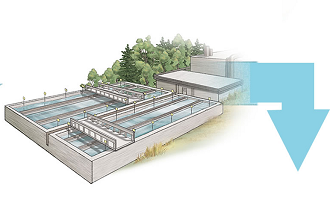
Water Treatment System
The source water from our lakes, rivers and groundwater must be treated so that any harmful contaminants and organisms are reduced or removed. In Ontario, municipalities use different water sources and provide the treatment needed, so that you and I can #TrustTheTap for safe, clean drinking water.
Read More |
|
Treatment processes reduce or eliminate the potential for the presence of chemicals and pathogens in drinking water and are used to ensure your drinking water meets provincial standards. Different water sources necessitate different levels and methods of treatment to ensure safe, clean water is provided to consumers. All municipal drinking water systems in Ontario must have a disinfection process in place and all water must be disinfected before it is supplied to the public. The most widely used disinfectant is chlorine, which is a low-cost powerful disinfectant which continues disinfecting as water passes through the distribution system. In order to comply with the provisions of Ontario Regulation 170/03, Drinking-Water Systems, (a regulation under the Safe Drinking Water Act, 2002) all municipal drinking water systems in Ontario must:
These requirements ensure an adequate level of removal or inactivation of pathogenic organisms that may be present in the raw water, prevent re-contamination of drinking water within the distribution system, and, maintains drinking water quality throughout the distribution system. Skilled and competent drinking water system operators are crucial to maintaining safe water quality. They operate disinfection and treatment equipment, respond to equipment alarms and test and treat drinking water to help ensure that it is safe to drink. Ontario Regulation 128/04, Certification of Drinking Water System Operators and Water Quality Analysts (another regulation under the Safe Drinking Water Act, 2002) ensures that drinking water systems maintain fully qualified and trained staff. The regulation provides the framework for the certification of drinking water operators, and the Ministry of the Environment Operator Certification Program. Once certified, operators are required to renew their certificates every three years. |
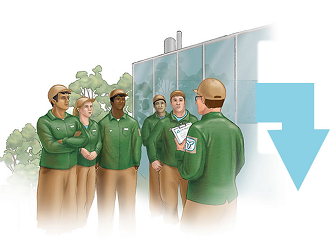
Inspection
The government of Ontario carries out inspections of municipal residential drinking water systems per the Safe Drinking Water Act. An inspection rating is given to each system to show how well it follows the rules. If a problem is found, the inspector can prescribe timely corrective actions.
Read More |
|
There is a Compliance and Enforcement regulation of the Safe Drinking Water Act. This regulation sets out responsibilities of the provincial government to be legally accountable for its oversight role in protecting drinking water. These responsibilities include:
In Ontario, all municipal residential drinking water systems are inspected at least once a year. During an inspection, the inspector evaluates requirements such as the operation of the treatment system, policy Each system is assigned an inspection rating that reflects how well the system complied with requirements. Of the 659 inspections conducted in 2018-19, 656 or 99.5% received an inspection rating greater than 80%, with 477 or 72% scoring 100%. In cases where the inspection identifies a problem, the inspector can work with the system owner to bring the system into compliance or issue an order that prescribes corrective actions within a certain timeframe |
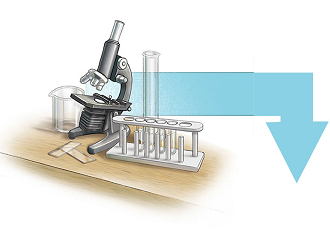
Testing
Trained and certified operators regularly test our municipal residential drinking water. This is a good way to check the quality of drinking water and also the system’s ongoing ability to provide safe drinking water. If a test shows any problems with the water quality, corrective actions are applied.
Read More |
| Ontario’s drinking water is carefully monitored through regular testing by certified operators who take thousands of drinking water samples every year which are tested at provincially licensed and eligible laboratories for microbiological organisms and chemical substances. Drinking water quality test results are a good way to demonstrate the quality of drinking water and provide ongoing evidence of a system’s ability to provide safe drinking water.
In Ontario, when systems have test results that do not meet standards, this often relates to microbiological and chemical exceedances. Corrective actions can include adjustments to treatment equipment or other operational activities. Successful implementation of these actions is often confirmed by resampling. In 2018-19, 99.87% or 522,231 of the 522,921 drinking water test results from 661 municipal residential drinking water systems met the standards. |
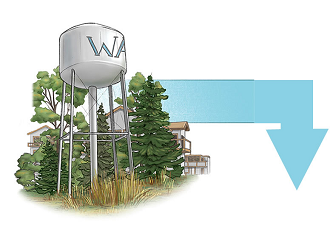
Distribution
The distribution system includes pipes, pumping stations, and more, to carry the treated drinking water to our property lines. Municipalities make sure that there is disinfectant in this system too, and test it regularly to check that clean, safe water is conveyed.
Read More |
| A water distribution system is the network of pipes, valves, fire hydrants, storage tanks, reservoirs and pumping stations that carry water to customers. If a distribution system is poorly maintained, then clean, treated drinking water can easily become contaminated. Municipal drinking water system owners are required to maintain a consistent level of disinfectant throughout the distribution system and in plumbing connected to the distribution system, to act as a barrier against contamination. This helps to protect water from microbiological re-contamination, reduce bacterial regrowth, control biofilm formation, and serves as an indicator of the integrity of the distribution system. Testing is also conducted within the distribution system to check the conveyance of safe drinking water. |
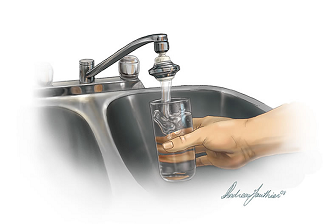
Drinking Water
More than 80% of Ontario’s population receives their drinking water from a municipal drinking water system! Pandemic or not, safe and abundant drinking water is one of the key pillars of public health. Protection of our drinking water is a shared responsibility, which is achieved through a multi-barrier approach.
Read More |
| Safe and abundant drinking water is one of the key pillars of public health in Ontario. Ensuring that Ontarians, regardless of socioeconomic status or geographic location, have access to safe drinking water is essential to the health of our population. Protection of our drinking water is a vital responsibility shared by many partners.
More than 80% of Ontario’s population receives their drinking water from a municipal drinking water system. Municipalities own or have water supplied to them through, various types of drinking water systems. In his inquiry report of the Walkerton tragedy, Justice O’Connor also recommended the adoption of quality management for municipal drinking water systems. As a result, the comprehensive Drinking Water Quality Management Standard (DWQMS) is mandated under the Safe Drinking Water Act, and provides a proactive and preventative approach to management strategies that identify and manage risks to public health. It supports the establishment and documentation of management procedures, clearly identifying roles and responsibilities; and allows for a continual improvement process. These form part of the multi-barrier approach in Ontario. There are two main types of non-municipal drinking water systems: non-municipal year-round drinking water systems and designated facilities. For more information about these systems, please visit: https://www.ontario.ca/page/rules-non-municipal-drinking-water-systems There are also laws around private wells on properties, including how to maintain a well, and how to properly close it. Read more at: https://www.ontario.ca/page/wells-your-property The watershed-based approach recommended by Justice O’Conner begins with protecting our precious sources of drinking water. This is a shared responsibility, and all of our actions matter. |
Successes of Multi-barrier Approach
- Since water quality test reporting began in 2004, more than 99.9% of the over 522,000 municipal drinking water system water quality tests continue to meet Ontario’s water quality standards.
- Ontario’s actions received an "A" ranking — the highest in Canada — in Ecojustice's Canada’s Drinking Water Report Card.
- There are 19 multi-stakeholder source protection committees across the province representing business, public, municipal and indigenous interests. These committees have developed 38 local source protection plans that identify actions to protect sources of municipal residential drinking water systems.
- The 38 source protection plans contain more than 12,500 policies to protect sources of municipal drinking water in Ontario for:
- Over 900 groundwater wells
- Over 70 Great Lakes intakes
- Over 60 inland lake intakes
- 13 Lake St. Clair and St. Lawrence River intakes.
- There are 22 prescribed drinking water threats being managed / removed from the landscape through source water protection. The list can be found here
- Over 1000 risk management plans have been established to manage drinking water threats on the landscape.
- 99.5% of 659 municipal residential drinking water systems received an inspection rating indicating over 80% compliance with Ontario’s regulations. 72% of systems received a perfect 100% rating.
- Over 5000 septic systems have been inspected for deficiencies
- As of March 31, 2019, there were 7,272 certified drinking water operators in Ontario who held a total of 10,040 certificates. This works out to a 22% increase over the last 10 years.
- Over 900 road signs have been installed on highways and major roads to identify the vulnerable areas around municipal drinking water systems.

 Account Login
Account Login